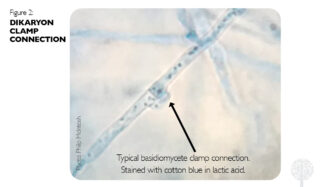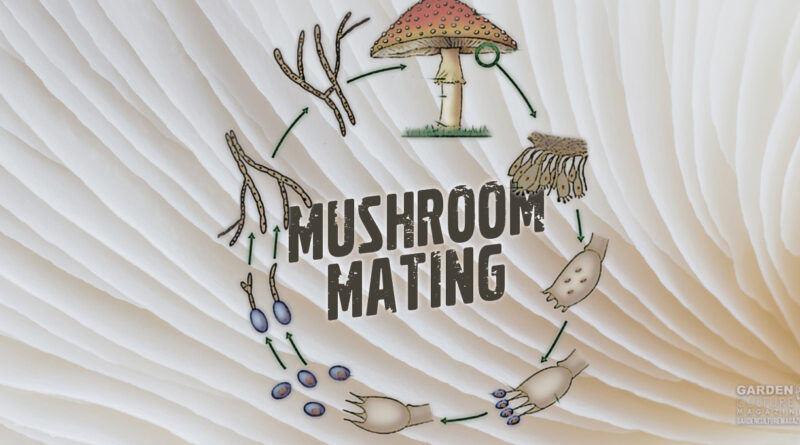So, You Want To Grow Mushrooms? Mushroom Mating Types Explained
So you want to grow a mushroom. Probably more than one. It helps to understand the life cycle of the species you wish to grow to succeed. Many mushroom-forming fungi require the fusion of cells between individuals with different mating types before there is any chance of producing mushrooms. The fusion of two compatible mycelia allows meiosis to occur (eventually), creating genetic diversity in the resulting spores. It’s mushroom sex, but fungi do not exist as males and females; they have mating types, and there can be more than just two.
For example, the model fungi Schizophyllum commune (split gill) and Coprinopsis cinerea (an inky cap) have an estimated 23,000 and 12,000 distinct mating types, respectively. With this many different mating types, the chances are high that any two individual fungi of the same species that encounter each other in the environment will be sexually compatible and able to reproduce. Many mushrooms grown commercially and by hobbyists must undergo some form of sexual reproduction before producing fruit bodies. To understand why, let’s review a typical basidiomycete mushroom life cycle (Figure 1).
How It Works
A single mushroom can release hundreds of millions of spores under ideal conditions throughout its existence. With few exceptions, fungal spores are haploid, meaning they contain a single copy of each chromosome. Most higher organisms, such as mammals, are diploid, having two copies of each chromosome in the nucleus. Any particular spore has little chance of germinating and developing into a fully-fledged fungal colony. But if a spore finds itself in the right place at the right time, it will grow to produce threadlike cells called hyphae, which comprise the mycelium or “body” of a fungus. The hyphae range out into the environment, releasing enzymes to break down organic material to be absorbed back into the mycelium as nutrients.
Homothallic vs Heterothallic
A mycelium derived from a single spore can produce mushrooms if the species is homothallic. However, most mushroom-forming fungi are heterothallic, meaning mating must occur between compatible individuals before fruit body formation and meiosis can happen. The classic example of a homothallic species is Agaricus bisporis, the common button mushroom. Well-known heterothallic species include:
- Pleurotus ostreatus (oyster).
- Hericium eriniceus (lion’s mane).
- Hydnum repandum (hedgehog).
- Lentinula edodes (shiitake).
- Members of the genus Psilocybe.
The Dikaryon


Haploid fungal cells derived from a single spore contain one nucleus per cell and are called homo- or monokaryons (mono = single, karyon = nucleus). When compatible mycelia of a heterothallic species encounter each other, the hyphae fuse and nuclei from each mycelium migrate into the opposite mycelium, forming a state unique to basidiomycetes—the dikaryon. Functionally, this is a diploid state, but it’s not technically a true diploid because even though there are two copies of each chromosome in each cell, the chromosomes exist in separate nuclei. The nuclei migrate to the tips of the growing hyphae, where the nuclei of opposite mating types pair up and divide synchronously to maintain the dikaryotic state indefinitely. Environmental queues such as nutrient deficiency and temperature and humidity changes trigger fruit body development, nuclear fusion, the completion of meiosis, and the formation of spores on the mushroom’s gill, spine, or pore surfaces. The spores produced in this way are genetic recombinants containing genes from both nuclei that formed the dikaryon.
A distinguishing feature of a dikaryon is the clamp connection (Figure 2). A clamp connection is formed at the location on a hypha where a new cell wall will create a septum, dividing the hypha into separate cells. A small hook-like protrusion forms in the reverse direction of growth, and as the two sister nuclei divide, one moves into the hook and migrates back into the cell behind. Using this mechanism, unique to basidiomycete fungi, the fungus maintains two nuclei in each advancing cell of the mycelium, one of each genotype.
Dikaryotic vs Monokaryotic Mycelium


Microscopic observation of hyphae to confirm clamp connections is a sure way to verify a dikaryon (although some heterothallic fungi do not produce clamp connections). With experience, a dikaryotic mycelium can be differentiated from a monokaryotic one by its colonial morphology. A dikaryon often has a much more “ropey” form with thicker, more entwined hyphae. Such a mycelium is called rhizomorphic because of its resemblance to the spreading and branched growth of fibrous plant roots. Some species are a lot more rhizomorphic than others. Monokaryons are generally a lot fluffier and fuzzier without twisted bundles of hyphae. Dikaryons tend to grow a little faster than monokaryons.
So now you know why you generally can’t grow a mushroom from a single spore. It takes two.




